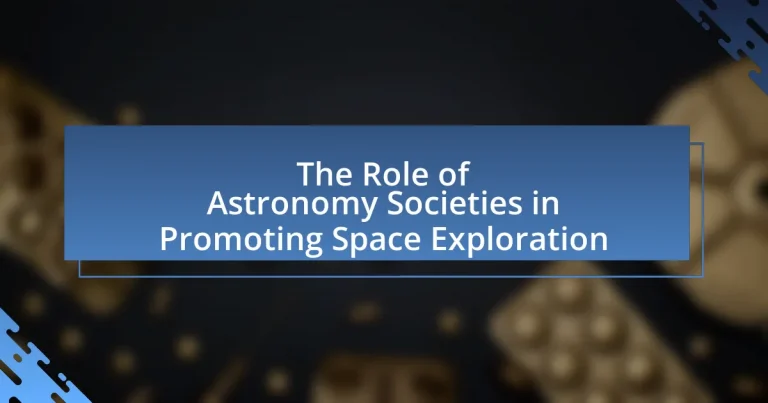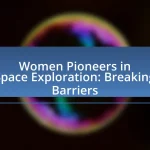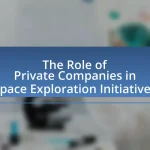Astronomy societies are pivotal in promoting space exploration by fostering public interest, education, and collaboration among enthusiasts and professionals. They organize events, lectures, and workshops that engage communities and provide accessible information about space science. These societies also advocate for funding and support for space programs, influencing policy decisions that impact exploration efforts. Through outreach initiatives, partnerships with educational institutions, and collaborations with governmental space agencies, astronomy societies enhance public awareness and inspire future generations in STEM fields. Additionally, they face challenges such as funding limitations and competition for public attention, which they address by adapting their strategies to remain relevant in the evolving landscape of space exploration.
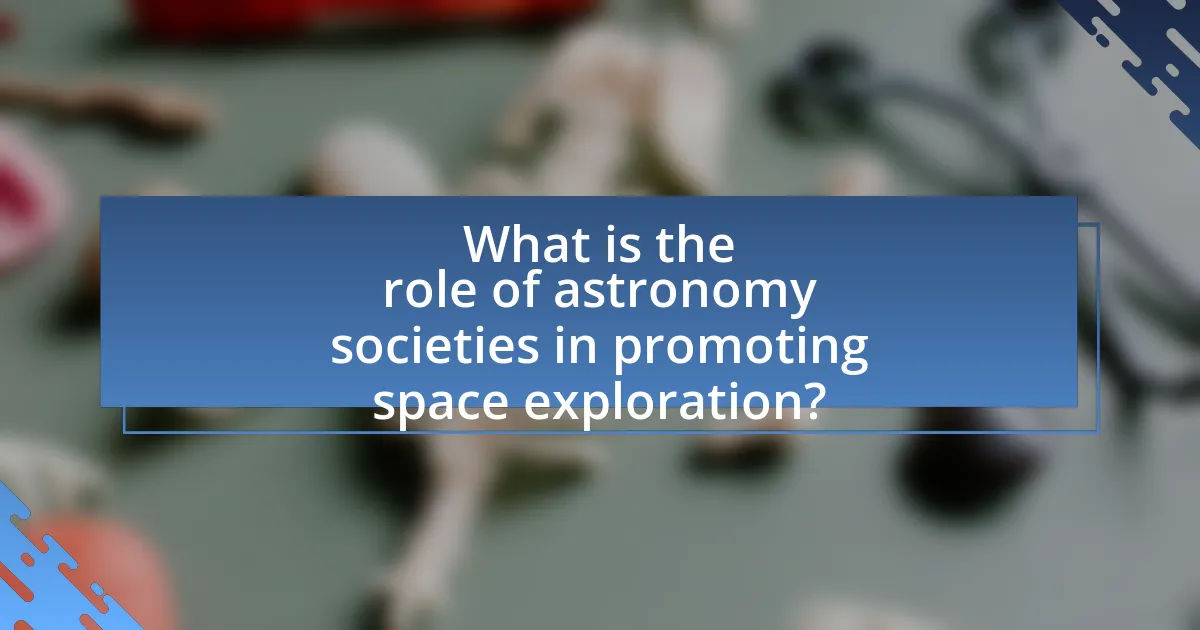
What is the role of astronomy societies in promoting space exploration?
Astronomy societies play a crucial role in promoting space exploration by fostering public interest, education, and collaboration among enthusiasts and professionals. These organizations often host events, lectures, and workshops that engage the community and provide accessible information about space science and exploration initiatives. For example, the American Astronomical Society organizes meetings that bring together researchers and the public, facilitating discussions on current space missions and discoveries. Additionally, astronomy societies often advocate for funding and support for space programs, influencing policy decisions that affect space exploration efforts. Their outreach programs, such as star parties and school visits, inspire the next generation of scientists and engineers, thereby contributing to the long-term sustainability of space exploration.
How do astronomy societies contribute to public awareness of space exploration?
Astronomy societies enhance public awareness of space exploration through educational programs, community outreach, and public events. These organizations often host lectures, workshops, and star-gazing nights that engage the community and provide accessible information about current space missions and discoveries. For instance, the American Astronomical Society organizes events that attract thousands of participants, fostering interest in astronomy and space science. Additionally, astronomy societies frequently collaborate with schools and universities to promote STEM education, thereby increasing knowledge and enthusiasm for space exploration among younger audiences.
What educational programs do astronomy societies offer to engage the community?
Astronomy societies offer various educational programs to engage the community, including public lectures, workshops, star parties, and school outreach initiatives. Public lectures often feature expert speakers discussing current astronomical research and discoveries, fostering interest and understanding among attendees. Workshops provide hands-on experiences, such as telescope usage and astrophotography, allowing participants to actively engage with the subject matter. Star parties invite community members to observe celestial events through telescopes, enhancing appreciation for the night sky. School outreach initiatives involve presentations and activities tailored for students, promoting STEM education and inspiring future generations in the field of astronomy. These programs collectively aim to increase public awareness and enthusiasm for space exploration.
How do outreach events organized by astronomy societies impact public interest in space?
Outreach events organized by astronomy societies significantly enhance public interest in space by providing accessible educational experiences and fostering community engagement. These events, such as star parties, lectures, and workshops, allow participants to interact directly with experts and engage with astronomical phenomena, making complex concepts more relatable. Research indicates that such hands-on experiences can increase knowledge retention and enthusiasm for science; for instance, a study published in the Journal of Astronomy & Earth Sciences Education found that participants in astronomy outreach programs reported a 30% increase in their interest in space-related topics. This direct engagement not only cultivates a deeper understanding of space but also inspires future generations to pursue careers in STEM fields, thereby contributing to a sustained interest in space exploration.
What partnerships do astronomy societies form to enhance space exploration efforts?
Astronomy societies form partnerships with educational institutions, governmental space agencies, and private aerospace companies to enhance space exploration efforts. These collaborations facilitate knowledge sharing, funding opportunities, and access to advanced technology. For instance, partnerships with NASA allow societies to participate in citizen science projects, such as the Mars rover missions, where members contribute to data analysis and public outreach. Additionally, collaborations with universities enable joint research initiatives and internships, fostering the next generation of astronomers and engineers. Such alliances are crucial for pooling resources and expertise, ultimately advancing the field of space exploration.
How do collaborations with educational institutions benefit astronomy societies?
Collaborations with educational institutions benefit astronomy societies by enhancing access to resources, expertise, and outreach opportunities. These partnerships allow astronomy societies to leverage academic research, utilize advanced facilities, and engage with students and educators, thereby fostering a greater interest in astronomy and space exploration. For instance, joint programs can lead to increased public engagement through workshops and lectures, which have been shown to boost community participation in astronomy-related events. Additionally, educational institutions often provide funding and grants that support research initiatives and public outreach, further solidifying the role of astronomy societies in promoting space exploration.
What role do astronomy societies play in partnerships with governmental space agencies?
Astronomy societies play a crucial role in partnerships with governmental space agencies by facilitating public engagement, education, and collaboration on scientific research. These societies often serve as intermediaries, helping to disseminate information about space missions and discoveries to the public, thereby fostering interest in space exploration. For instance, organizations like the American Astronomical Society collaborate with NASA to promote educational programs and outreach initiatives that enhance public understanding of astronomy and space science. Additionally, astronomy societies contribute to citizen science projects, allowing the public to participate in data collection and analysis, which can support governmental research efforts. This partnership enhances the overall impact of space exploration initiatives by leveraging community involvement and expertise.
Why are astronomy societies important for amateur astronomers and enthusiasts?
Astronomy societies are important for amateur astronomers and enthusiasts because they provide a platform for education, collaboration, and access to resources. These societies facilitate learning through workshops, lectures, and star parties, allowing members to enhance their knowledge and skills in astronomy. Additionally, they foster a sense of community among enthusiasts, enabling networking and sharing of experiences. Research indicates that participation in such societies can significantly increase engagement in astronomy-related activities, as evidenced by a study published in the Journal of Astronomy Education, which found that members of astronomy clubs reported higher levels of observational practice and knowledge retention compared to non-members.
How do astronomy societies support amateur astronomers in their pursuits?
Astronomy societies support amateur astronomers by providing resources, education, and community engagement opportunities. These societies often organize workshops, lectures, and star parties, which facilitate learning and hands-on experience with telescopes and observational techniques. For instance, the American Astronomical Society offers educational materials and networking opportunities that enhance the skills and knowledge of amateur astronomers. Additionally, societies may provide access to equipment and observatories, enabling members to conduct their own astronomical observations and research. This structured support fosters a collaborative environment that encourages exploration and discovery in the field of astronomy.
What resources do astronomy societies provide to foster a community of enthusiasts?
Astronomy societies provide various resources to foster a community of enthusiasts, including educational programs, access to telescopes, and organized events. These societies often host workshops, lectures, and star parties that encourage learning and collaboration among members. For instance, many societies offer mentorship programs where experienced astronomers guide newcomers, enhancing knowledge sharing. Additionally, societies frequently maintain observatories and provide access to specialized equipment, allowing members to engage in hands-on astronomy. This structured support not only cultivates a sense of belonging but also promotes active participation in astronomical research and exploration.
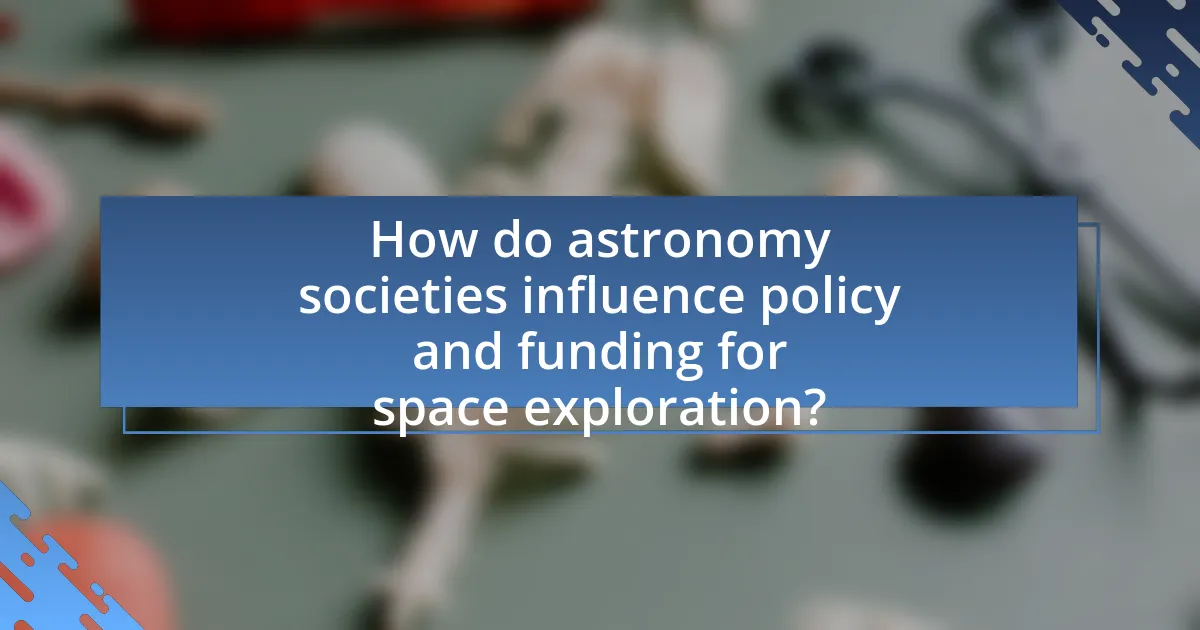
How do astronomy societies influence policy and funding for space exploration?
Astronomy societies influence policy and funding for space exploration by advocating for scientific research, public engagement, and collaboration with governmental and private entities. These organizations often provide expert testimony, publish position papers, and mobilize their members to communicate the importance of space exploration to policymakers. For instance, the American Astronomical Society has actively participated in discussions with Congress regarding NASA’s budget, emphasizing the need for sustained funding to support scientific missions. Their efforts have contributed to increased public awareness and support for space initiatives, which can lead to more favorable policy decisions and funding allocations.
What advocacy efforts do astronomy societies engage in to promote space exploration funding?
Astronomy societies engage in various advocacy efforts to promote space exploration funding, including lobbying government officials, organizing public outreach campaigns, and collaborating with educational institutions. These societies often participate in initiatives like the “Space Advocacy Day,” where members meet with legislators to discuss the importance of funding for space missions and research. Additionally, they create educational programs and public events to raise awareness about the benefits of space exploration, which can influence public opinion and, subsequently, funding decisions. For instance, the American Astronomical Society has been active in advocating for increased NASA budgets, highlighting the economic and scientific returns of space exploration.
How do astronomy societies communicate the importance of space exploration to policymakers?
Astronomy societies communicate the importance of space exploration to policymakers through advocacy, research dissemination, and public engagement initiatives. These organizations often produce policy briefs that highlight the scientific, economic, and societal benefits of space exploration, such as advancements in technology and international collaboration. For instance, the American Astronomical Society regularly engages with lawmakers by providing data-driven reports that emphasize the return on investment in space programs, demonstrating that every dollar spent on NASA generates approximately $10 in economic returns. Additionally, astronomy societies organize events and workshops that facilitate direct dialogue between scientists and policymakers, ensuring that decision-makers are informed about the latest discoveries and their implications for society.
What strategies do astronomy societies use to mobilize public support for space initiatives?
Astronomy societies mobilize public support for space initiatives through educational outreach, community engagement, and advocacy efforts. These organizations conduct public lectures, workshops, and star-gazing events to raise awareness about space science and exploration, effectively engaging diverse audiences. For instance, the American Astronomical Society has implemented programs that connect local communities with scientists, fostering interest in space initiatives. Additionally, astronomy societies often collaborate with schools to integrate astronomy into curricula, which helps cultivate a future generation of space enthusiasts. They also advocate for space funding and policy changes by organizing campaigns and petitions, demonstrating their commitment to advancing space exploration.
How do astronomy societies contribute to the development of space exploration policies?
Astronomy societies contribute to the development of space exploration policies by advocating for scientific research, public engagement, and collaboration among stakeholders. These organizations often provide expert opinions and recommendations to policymakers, ensuring that decisions are informed by the latest astronomical research and technological advancements. For instance, the American Astronomical Society has actively participated in discussions regarding the National Aeronautics and Space Administration’s (NASA) budget and priorities, influencing funding allocations for space missions. Additionally, astronomy societies facilitate outreach programs that educate the public and policymakers about the importance of space exploration, thereby fostering a supportive environment for policy development.
What role do astronomy societies play in shaping national and international space policies?
Astronomy societies play a crucial role in shaping national and international space policies by advocating for scientific research, public engagement, and collaboration among stakeholders. These organizations often provide expert input to policymakers, influencing legislation and funding priorities related to space exploration. For instance, the American Astronomical Society has actively participated in discussions surrounding the National Aeronautics and Space Administration’s budget, emphasizing the importance of astronomy research in advancing technology and understanding the universe. Additionally, astronomy societies facilitate international cooperation through events and conferences, fostering partnerships that lead to collaborative space missions and shared scientific goals. This engagement not only enhances public awareness of space issues but also ensures that diverse perspectives are considered in policy formulation, ultimately shaping a more informed and effective approach to space exploration.
How do astronomy societies collaborate with other organizations to influence space policy?
Astronomy societies collaborate with other organizations to influence space policy through advocacy, research partnerships, and public outreach initiatives. These societies often join forces with governmental agencies, educational institutions, and non-profit organizations to promote scientific research and policy changes that support space exploration. For instance, the American Astronomical Society has actively engaged with NASA and the National Science Foundation to advocate for funding and policies that enhance astronomical research and education. Additionally, collaborative efforts such as the Coalition for Astronomy and Space Science emphasize the importance of astronomy in addressing global challenges, thereby influencing policy decisions at various governmental levels.
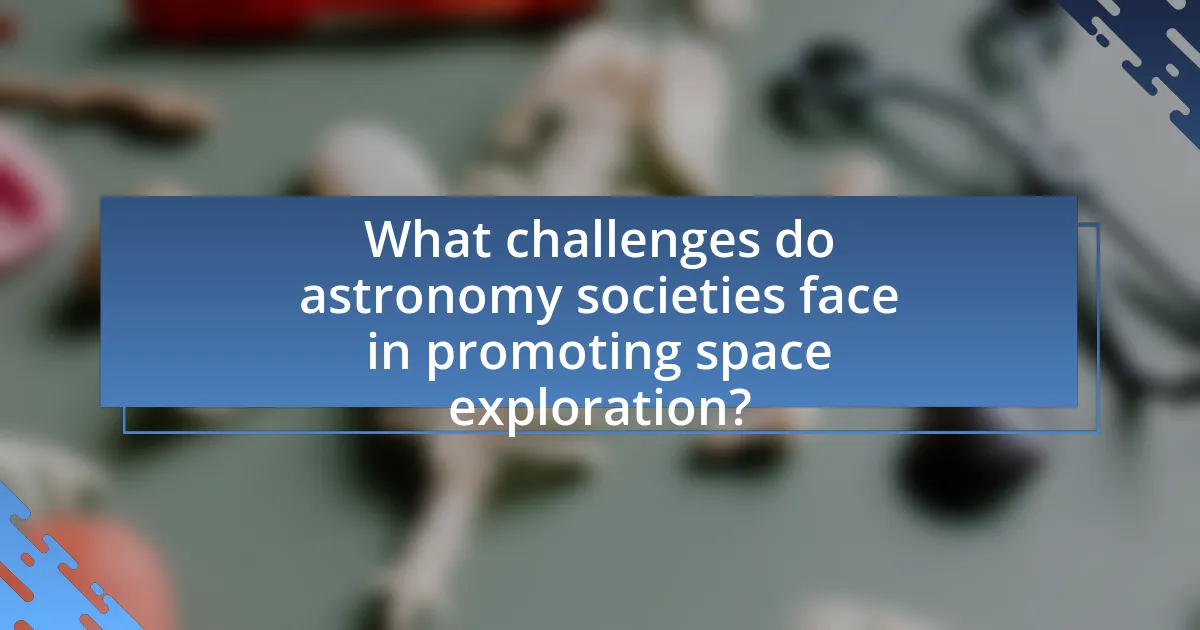
What challenges do astronomy societies face in promoting space exploration?
Astronomy societies face several challenges in promoting space exploration, primarily including funding limitations, public engagement, and competition with other scientific fields. Funding limitations restrict their ability to organize events, outreach programs, and educational initiatives, which are essential for raising awareness about space exploration. For instance, many societies rely on grants and donations, which can fluctuate and may not cover all necessary expenses. Public engagement is another significant challenge, as societies must compete for attention in a media landscape saturated with various interests, making it difficult to capture the public’s imagination about space. Additionally, competition with other scientific fields for resources and interest can dilute the focus on astronomy and space exploration, as seen in the growing emphasis on climate science and technology. These factors collectively hinder the effectiveness of astronomy societies in their mission to promote space exploration.
What are the main obstacles that astronomy societies encounter in their outreach efforts?
Astronomy societies encounter several main obstacles in their outreach efforts, including limited funding, lack of public interest, and competition from other recreational activities. Limited funding restricts the ability of these societies to organize events, purchase equipment, and promote their programs effectively. For instance, a survey by the American Astronomical Society found that 60% of astronomy clubs reported financial constraints as a significant barrier to outreach. Additionally, a lack of public interest in astronomy can hinder participation, as many individuals prioritize other interests over science-related activities. Lastly, competition from various entertainment options, such as video games and streaming services, diverts potential audiences away from astronomy events, making it challenging for societies to attract and engage the public.
How do funding limitations affect the activities of astronomy societies?
Funding limitations significantly restrict the activities of astronomy societies by reducing their ability to organize events, conduct research, and maintain equipment. For instance, many societies rely on membership fees and donations, which can fluctuate, leading to budget constraints that limit outreach programs and public engagement initiatives. A study by the American Astronomical Society found that 60% of astronomy clubs reported decreased funding over the past decade, directly impacting their ability to host star parties, educational workshops, and community events. Consequently, these limitations hinder the societies’ roles in promoting space exploration and public interest in astronomy.
What challenges do astronomy societies face in engaging diverse audiences?
Astronomy societies face significant challenges in engaging diverse audiences, primarily due to a lack of representation and accessibility. Many societies struggle to reflect the demographics of their communities, which can lead to feelings of exclusion among underrepresented groups. For instance, a study by the National Science Foundation found that only 20% of science and engineering degrees are awarded to underrepresented minorities, indicating a broader issue of inclusivity in STEM fields. Additionally, the technical language and complex concepts often used in astronomy can alienate individuals without a scientific background, further hindering engagement. These barriers highlight the need for astronomy societies to adopt more inclusive practices and simplify communication to effectively reach and engage diverse audiences.
How do astronomy societies adapt to changes in the space exploration landscape?
Astronomy societies adapt to changes in the space exploration landscape by evolving their educational programs, outreach initiatives, and collaboration efforts. These organizations often update their curricula to include the latest discoveries and technologies, such as advancements in telescopes and space missions, ensuring that members and the public remain informed. For instance, many societies now host webinars and workshops that focus on current events in space exploration, like Mars rover missions or exoplanet discoveries, which engage a broader audience. Additionally, they collaborate with space agencies and research institutions to provide members with access to exclusive data and opportunities for citizen science projects, thereby enhancing community involvement in ongoing research. This adaptability is crucial as it allows astronomy societies to maintain relevance and foster a culture of curiosity and learning in an ever-evolving field.
What strategies do astronomy societies employ to stay relevant in a rapidly evolving field?
Astronomy societies employ several strategies to remain relevant in a rapidly evolving field, including fostering community engagement, embracing technology, and collaborating with educational institutions. By organizing public outreach events, such as star parties and lectures, these societies enhance public interest and participation in astronomy. Additionally, they utilize digital platforms and social media to disseminate information and connect with a broader audience, adapting to the increasing reliance on technology for communication. Collaborations with schools and universities allow astronomy societies to integrate current research and educational resources, ensuring that their programs reflect the latest advancements in the field. These strategies collectively help astronomy societies maintain their significance and influence in promoting space exploration.
How do astronomy societies leverage technology to enhance their outreach and education efforts?
Astronomy societies leverage technology by utilizing digital platforms, social media, and interactive tools to enhance outreach and education efforts. These societies create online resources such as webinars, virtual star parties, and educational videos that make astronomy accessible to a broader audience. For instance, the American Astronomical Society has implemented online educational programs that reach thousands of participants, demonstrating the effectiveness of technology in expanding their educational impact. Additionally, mobile apps and software for stargazing allow users to engage with celestial events in real-time, further promoting interest in astronomy.
What best practices can astronomy societies adopt to effectively promote space exploration?
Astronomy societies can effectively promote space exploration by engaging in public outreach programs that educate and inspire communities about space science. These societies should organize events such as star parties, lectures, and workshops that provide hands-on experiences with telescopes and discussions led by experts in the field. Research indicates that community engagement increases public interest in space; for instance, the American Astronomical Society reported that outreach initiatives significantly boost attendance at local astronomy events, fostering a deeper understanding of space exploration. Additionally, collaborating with schools to integrate astronomy into the curriculum can cultivate interest among students, as demonstrated by programs like NASA’s “Universe in the Classroom,” which successfully enhances student engagement in STEM fields.
How can astronomy societies improve their community engagement strategies?
Astronomy societies can improve their community engagement strategies by implementing interactive public events and educational programs that cater to diverse audiences. These initiatives can include hands-on workshops, star parties, and school outreach programs, which have been shown to increase public interest in astronomy. For instance, a study by the National Science Foundation found that community-based astronomy events significantly enhance public understanding of scientific concepts and foster a sense of community. By actively involving local schools and organizations, astronomy societies can create partnerships that broaden their reach and impact, ultimately promoting greater interest in space exploration.
What innovative approaches can astronomy societies take to enhance their educational programs?
Astronomy societies can enhance their educational programs by integrating technology such as virtual reality (VR) and augmented reality (AR) to create immersive learning experiences. These technologies allow participants to explore celestial bodies and phenomena in a more engaging manner, which has been shown to improve retention of complex astronomical concepts. For instance, a study by the University of California, Berkeley, demonstrated that students using VR to simulate space exploration exhibited a 30% increase in understanding compared to traditional teaching methods. Additionally, astronomy societies can collaborate with local schools to develop hands-on workshops that incorporate citizen science projects, enabling participants to contribute to real research while learning about astronomy. This approach not only fosters a deeper connection to the subject but also encourages community involvement in scientific discovery.
